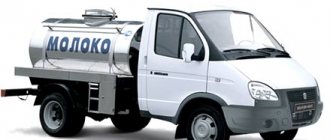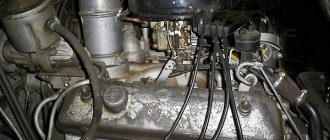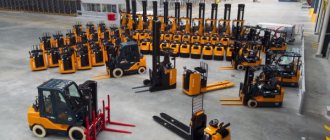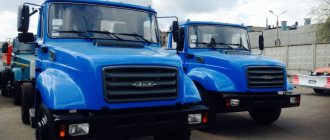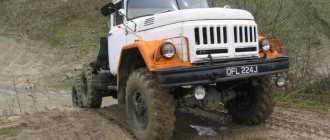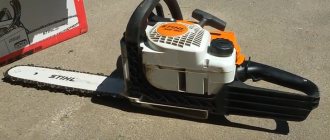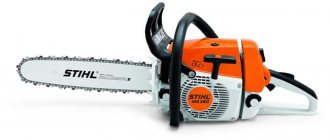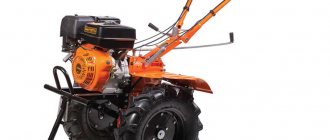Service
Servicing the motor is quite simple. The service interval is 15,000 km. During maintenance, the engine oil and centrifugal oil filter are changed.
Each maintenance is a whole complex of operations aimed at maintaining the technical condition of the car. What is included in the maintenance of YaMZ 236 series engines:
- Change of oil.
- Adjusting the valve mechanism.
- Replacing filters. So, depending on the engine modification, the following filter elements may or may not be present: a fine and coarse oil filter, a filter element for coarse and fine fuel purification, an air filter.
- Other operations aimed at maintaining the power unit.
K444OT › Blog › Weight of Units and Bodywork
While rummaging through the Internet I found this information, I think it will be useful to everyone.
Complete unit (with gearbox and transfer case)
GAZ-67 engine with gearbox and transfer case (transfer case is integrated into the gearbox) - 248 kg GAZ-69 engine with gearbox and transfer case - 280 kg GAZ-66 engine with gearbox and transfer case - 380 kg ZIL-130 engine (431410) with gearbox and parking brake - 640 kg UAZ-3151 (UMZ-4179) engine with gearbox and transfer case - 240 kg Engine
GAZ-66 engine - 275 kg ZIL-130 engine (431410) - 500 kg UAZ-3151 engine (UMZ-4179) - 165 with clutch Mitsubishi 4D56 engine - 215 kg Mitsubishi 4G64 engine - 195 kg Mitsubishi 4 engine M40 - 270 kg Mitsubishi engine 6G72 - 225 kg Nissan TD27 engine - 250 kg Nissan RD28 engine - 255 kg Nissan TD42 engine - 365 kg Toyota 1HDFTE engine - 365 kg HUYNDAI D4BH engine - 220 kg VAZ 21214-1000260-32 engine - 134.5 kg Engine VAZ 21213- 1000260-00 - 124 kg VAZ 2121 engine - 114 kg
GAZ-66 gearbox - 56 kg ZIL-130 gearbox (431410) without parking brake - 98 kg GAZ-69 gearbox - 28 kg UAZ 3151 gearbox - 36 kg Mitsubishi V5MT1 gearbox (manual transmission) with SuperSelect transfer case - 110 kg Mitsubishi V4AW3 gearbox (automatic transmission) ) with SuperSelect transfer case - 140 kg VAZ-2121 gearbox (with clutch housing) - 32 kg
Transfer case GAZ-66 - 49 kg, with brake 57 Transfer case UAZ-3151 with brake - 37 Transfer case GAZ-69 - 43 Transfer case VAZ-2121 - 27.6 kg
Cooling system radiator
Radiator ZIL-130 (431410) - 21 kg Radiator GAZ-53 - 21 kg Radiator VAZ-2121 - 7 kg Radiator GAZ-24 - 10 kg Radiator GAZ-69 - 16 kg
Frame GAZ-69 - 125 Frame GAZ-66 - 290 Frame UAZ-3151 - 112
Fuel tank 21213 with sensor - 4.8 kg Fuel tank Gazelle, GAZ-3307, GAZ-66 100l all-purpose - 14 kg Fuel tank UAZ-3303 onboard - 9.1 kg Fuel tank UAZ-469 left assembled 7.2 kg
complete body (1 set)
GAZ-69 body — 409 GAZ-66 cabin assembly — 360 VAZ-2121 body assembly — 520 UAZ-3151 body assembly — 475 UAZ Patriot body assembly — 760 UAZ Hunter body assembly (rear swing door) — 590 Body UAZ-31514-84 (with an iron roof, soft seats, folding tailgate) - 587 kg UAZ-3303 cab (flatbed) assembled (with seats) - 268 UAZ-3741 body (manufactured goods non-glazed van) - 592 UAZ-cab- 39094 Peasant (5-seater double cab) - 610 UAZ 3962 body (nurse, glazed, with folding benches) - 765 naked body (base, 3rd set)
Body with frame Pajero II short V24W (base, 3rd set) -415 kg Body base painted UAZ Patriot - 420 Boat UAZ 31512 (469), under an awning - 249 Body base UAZ Hunter (rear swing door) - 241 Body base UAZ-31514 (tailgate) - 249 Cabin UAZ-3303 (flatbed) base - 160 Body base UAZ-3741 (manufactured goods non-glazed van) - 400 Cabin UAZ-39094 Peasant (5-seater double cab, base) - 180 Body base UAZ 3962 (nurse, glazed, with folding benches) - 400 Removable roof
Roof of UAZ 3151-40 under a tailgate with upholstery and glazing - 91 kg Roof of UAZ 3151-95 under a rear hinged door with upholstery and glazing - 83 kg
Hood without sound insulation MMC Pajero II without nostrils - 17.7 kg GAZ-69 hood - 12 kg VAZ-2121 hood - 15 kg UAZ-3163 hood (Patriot) - 15.8 kg UAZ-469 hood - 13.1 kg
Front wing MMC Pajero II dorestayle, without extension (fender) - 4.8 kg Front wing VAZ-2121 - 5.8 kg Wing UAZ 469 - 4.3 kg Wing UAZ Patriot 3163 - 5.2 kg
Trunk door VAZ-21214 (naked) - 8.5 kg Trunk door UAZ-3162 (naked) - 22 kg
Door UAZ-3160, Patriot front (naked) - 17.7 kg Door VAZ-21214 (naked) - 14.4 kg Windshield
Windshield MMC Pajero II - 11.5 kg
Rear axle assembly with brakes
Rear axle GAZ-66 — 250 Rear axle GAZ-69 — 90 Rear axle UAZ-31512 (collective farm) — 100 Rear axle UAZ-3151 (military) — 122 Axle VOLVO Laplander 170 Rear axle MMC Pajero 9.5″ (spring suspension) — 115 Rear axle MMC Pajero 8″ (spring suspension) — 95 Rear axle MMMC Pajero 8″ (spring suspension, LSD) with oil, handbrake cables — 93 Rear axle VAZ-2121 — 60 kg
Front axle GAZ-66 330 kg Front axle GAZ-69 120 kg Front axle UAZ-31512 (collective farm) - 120 kg Front axle UAZ-3151 (military) - 140 kg Front axle VAZ-2121 (with front wheel drive) - 32 kg
GAZ-66 cardan drive - 36 kg UAZ-3151 driveshafts - 15 kg
Wheel (standard, factory)
Wheel with GAZ-69 tire - 30 Wheel with GAZ-67 tire - 29 Wheel with UAZ-3151 tire - 39 Wheel with GAZ-66 tire - 118 Wheel with VAZ-2121 tire - 21
wheel disk (factory)
metal VAZ-2121 16″ — 8.7 kg steel VAZ-2123 15″ — 9.0 kg metal UAZ-452-3101015-01 15″ — 11.7 kg steel UAZ-452-3101015 16″ — 13.1 kg cast MMC Pajero II 7×15″ - 9.5 kg
Source: www.drive2.ru
ZIL 131 - for the army and not only
According to the seven-year plan for the development of the national economy, adopted in 1959 at the XXI Congress of the CPSU, before the workers of the automobile plant named after. Likhachev (until 1956 - the Moscow Automobile Plant named after Stalin) was given the task of establishing the production of the ZIL-130, which was fundamentally new for that time, and its modification ZIL 131. The first prototype of the ZiS-131 was manufactured back in 1956, but mass production The release of the car, planned for 1961-62, was postponed due to a number of difficulties.
Based on the results of factory and acceptance tests, the new ZIL-130 hit the assembly line only in the fall of 1964, and the ZIL-131 even later - in 1967, but during this time the designers managed to improve its design and improve some operational characteristics.
The ZIL 131, based on the “one hundred and thirty”, was designed to replace the outdated ZIL-157 family of cargo trucks that did not meet the needs of the Soviet Army. And he succeeded.
The new all-terrain vehicle boasted higher payload and speed, a more comfortable cabin and softer suspension, and lower fuel consumption. But let's talk about everything in order.
Design features of ZIL 131
This truck is a hood type vehicle. The all-metal cabin of the ZIL 131, accommodating a driver and two passengers, was borrowed from the civilian ZIL-130. However, the military, to which the truck was presented, were not delighted with the curved wings of the complex shape and the ornate radiator grille, so the designers had to install a simpler cabin from the ZIL-165 prototype. For the mid-60s.
its design could be called revolutionary. Although over the almost 40-year history of production of this ZiL model, its appearance has remained virtually unchanged, with a simple radiator lining and equipped with flat curved wings, the cabin still looks good. Compared to the ascetic ZIL-157, ZIL 131 had a higher level of comfort.
In addition, the designers made the windshield panoramic, consisting of two halves, which provided better visibility.
Despite the original design, the car was in many ways similar to other all-terrain trucks produced by the Soviet automobile industry, for example, the Ural-375 or ZIL-157K. This commonality of technical solutions was dictated by a unified design strategy for Soviet trucks of this class.
The difference between the machines was a slightly different solution to technical problems and engineering methods for increasing cross-country ability. A lot of time was spent searching for compromises regarding reducing the cost and simplifying the main components and operating diagram of the Zil 131 and maintaining important performance qualities. Ultimately, the result pleased everyone - the new ZIL 131 became the best.
In theory, the production of the ZIL-157 should have been suspended after this, but, oddly enough, both trucks were produced by the car plant in parallel for almost another 20 years.
There were many modifications to the car
It is worth noting that the ZIL 131 began to be produced in three modifications, differing in the design of the cargo platform. One of the modifications was a truck equipped with a wooden lattice platform with arches and an awning. The army version was often used to transport personnel of the USSR armed forces. The folding benches could accommodate 16 people, and the removable bench installed in the middle could seat another eight. In the Soviet Army, this truck model was one of the most popular.
Another modification, ZiL 131 V, was a truck tractor and was intended for towing semi-trailers. The ZIL 131 X cargo truck was developed for operation in hot and desert areas. In general, this vehicle was distinguished by its reliability and could operate in absolutely any climatic conditions, even tropical ones, and the operating temperature did not matter - from -40° to + 50° .
As for the total number of modifications of this model, during the entire production period it was more than fifteen. The universal automobile chassis of the 131 model made it possible to install special-purpose add-ons. For example, it became the basis for the installation of various types of weapons - the Volkhov, S-125 and even Katyusha air defense systems, originally based on the ZiS-6 chassis. Often a closed van body was mounted on the chassis. ZIL 131 Kung could be used for transporting personnel, repair shops, first aid stations, field kitchens, electronic systems, etc.
Conclusion
The design and repair of the ZIL 131 power unit provided in the article is superficial. The ZIL 131 engine has become a legend of an entire era, but even at this moment it continues to be fully exploited. The engine is often repaired and serviced with your own hands, and therefore it is relatively profitable to maintain.
The only serious drawback is the high consumption, which impacts the owner’s expenses.
Article rating:
Save to:
Weight of ZIL 131 units Link to main publication
Related publications
- How to use a tubeless tire repair kit
- VAZ 2110 vacuum booster replacement
- How to raise a Kia Spectra
- Mazda 3 clutch replacement
- Checking spark plugs with a multimeter
- Why 92 grade gasoline is not suitable for modern engines
- What is it better not to go out on the road at night without?
- Fine for driving without a seat belt
- Input shaft bearing noise
- Lada Granta vs Renault Logan
- Hummer category B or C
- Original alloy wheels for Lada Vesta
Transmission unit
Knowing the weight of the ZIL-131, it is necessary to understand the type of system that controls the movement of such a large machine. The truck in question is equipped with a manual transmission with 5 modes. The block circuit includes a pair of inertial synchronizers. The transfer case is also mechanical, with a cardan transmission in an open configuration.
A dry single-plate clutch is combined with a spring type damper of rotational vibrations. The element is located on the driven disk. The number of rubbing pairs is two, the friction linings are made of asbestos composition. Some car models are equipped with a winch, an additional worm gear, and the cable length is 65 meters.
Overview of modifications
Since the model became one of the most popular trucks of this manufacturer, over time it acquired many modifications that were developed to solve specific problems or improve overall performance. Among the most popular ones, worthy of mention are:
- 131A - a special version, where the electrical equipment was not shielded, there was no central bench, as well as a special searchlight;
- 131B - saddle version of the car with a shortened frame, towbar, two sets of spare tire;
- 131D - dump-type unit;
- 131C, 131AC - modifications intended for use in the Far North. Additional heating sources, frost-resistant materials;
- 131X - version for tropical latitudes;
- 131N - a modernized version with an improved engine and modern materials.
Weight, dimensions, load capacity
The weight and overall characteristics of the vehicle of this type are relatively small, despite its main purpose. The parameters are as follows:
- curb weight of the model without winch – 6,135 kg;
- curb weight of the model with winch is 6,375 kg.
Although, according to the technical specifications, the weight of the winch mechanism of the ZIL-131 vehicle is quite significant, its presence is always justified, since it allows you to cope with movement in extremely difficult and extreme terrain conditions.
Gross vehicle weight:
- with a winch - 10,425 kg;
- without winch - 10,185 kg.
The maximum load capacity is only 3,500 kg. Also, if necessary, the equipment in question can be used in conjunction with a trailer.
Its permissible weight depends on the road conditions in which the ZIL-131 travels:
- weight when driving on a paved road – 6,500 kg;
- when driving on a dirt road – 4,000 kg.
The basic version of the car has the following overall dimensions:
- length from the front bumper to the rear of the body, mm – 7,040;
- height without awning, mm – 2,480;
- height with awning, mm – 2,975;
- width from left wheel to right, mm – 2,500.
The ground clearance of the ZIL-131 is as much as 330 mm, which allows you to move without much difficulty even over rough terrain - in forests, fields or other similar places.
The distance between the wheels is 3.35 m +1.25 m. The width of the front and rear tracks is the same and is 1.82 m. The turning radius is as much as 10.8 m. Considering the length of the body, this parameter is not that great.
The braking distance is 29 m at 50 km/h. The reason for this is the large inertia arising from the mass of the entire car and van with people, as well as all the equipment available.
Soviet industry no longer exists, but its fruits remain
From 1966 to the beginning of the 90s, more than 1 million ZIL-131 vehicles of various modifications were produced. They were used not only in the Soviet economy and the Armed Forces, but were also widely supplied abroad to support comrades in the socialist camp. You can still see products of the Soviet automobile industry in the countries of Africa and Central Asia. The North Korean army is 100% equipped with Soviet ZILs. Time-tested, these vehicles have proven their durability and suitability for any climatic and road conditions.
Chassis design
The chassis of the car in question includes the following main components:
- governance mechanisms;
- chassis;
- main power train (transmission).
ZIL-131 control mechanisms include:
- power steering with mechanical connection to the front wheels;
- braking system.
The chassis includes the following components:
- frame;
- axles on which the wheels are located;
- pendants.
The final drive of this truck is double, its gear ratio is 7.34.
